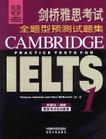剑桥雅思考试全题型预测试题集
出版时间:2002-4 出版社:外语教学与研究出版社 作者:杰克曼 页数:152
Tag标签:无
前言
IELTS(雅思)——国际英语水平测试——是由英国剑桥大学考试委员会(The Universityof Carnbridge Local Examinations Syndicate—UCLES)、澳大利亚教育国际开发署(IDP EducationAust.ralia)及英国文化委员会(The British Colmcil)联合开发的一种英语语言能力考试。目的是为准备进入以英语为主导教学语言的大学和学院进修的学生或以英语为母语的国家(目前指英联邦国家)移民人士测试英语水平而设。英国、澳大利亚、新西兰、加拿大、北美以及许多国家的众多院校均采用并认可这一语言测试系统。加拿大、澳大利亚、新西兰等国家的移民局均将这种考试成绩作为技术移民及其他类移民中衡量英语语言能力的唯一标准。 从1980年开始,雅思考试在全世界迅速发展,目前已经在105个国家设立了224.个考点。中国大陆的北京、上海、成都、重庆、福州、广州、杭州、济南、南京、沈阳、深圳、天津、武汉、西安、厦门和大连等地都设有考点,每年都有数以万计的人员参加此项考试。 IEL TS考试包括两类: 培训类(General Training)目前较多适用于移民 学术类(Academic) 目前较多适用于留学 雅思考试全程时间2小时55分钟(包括听力的10分钟填写答题纸)。 一、听力部分(General Training和Academic试卷一致) 通常考生会听到4段语音(独白部分及2人或多人对话部分)。共给38—42小题作答,考生将只听到(一次)语音,不会重复(边听边作答)此部分。所以考生作答时,千万别等待语音结束才作答(不要回头作答),考生可把答案先写在试卷上,30分钟会话结束后,利用额外10分钟,再腾写在答题纸上。四段语音前两段中,内容以一般生活及社会状态、人际关系等不同情况模拟为主,后两段则针对具教育性、学术性、世界性的主题探讨,以对答(叙述)为主,但因其非常具有实际性、常识性,考生不必钻牛角尖。在会话进行中,边听边记录所听到的重点答案,记在问卷上(非答案卷),以免忘记或漏掉答案。
内容概要
本书包含国际英语语言测试系统(雅思)的训练资料:针对学术类雅思考生的四套完整的模拟试题和针对一般类雅思考生的阅读和写作补充练习。本书由经验丰富的雅思考官编写,模拟试题的结构和形式与修改后的雅思考试的试卷结构完全一致。 这本自学用书包含雅思考试各项题型的介绍、不同的雅思考试问题类型的解析和如何应考的一些建议。书后所附的每套模拟试题的注释答案和听力录音文本使本书非常适合学生部分或全部地使用本书资料用于自学。 本书磁带包含听力部分的录音资料,这些资料选材经典,从时间安排、组织形式,说话者的类型和语调上反映测试的真实效果。
作者简介
内容介绍:国际英语语言测试系统(IELTS考试,中译“雅思”考试)是广泛受认可的可靠评估系统,目的是测试学生是否具备以英语作为学习或受训媒介语的条件。这些测试练习让准备参加IELTS考试的学生知道自己是否达到所需的英语水平。
剑桥大学出版社是剑桥大学考试委员会(UCLES)雅思培训资料的惟一官方出版机构,本套教程中所包含的全真试题资料由剑桥大学考试委员会提供,极具权威性和实用性。同时,该套教程也是英联邦国家雅思培训机构专用教材,在雅思培训方面具有不可替代的作用,其中《剑桥雅思考试全真试题解析》一书素有雅思考试培训“圣经”的美称
书籍目录
前言IntroductionPractice Test1Practice Test2Practice Test3Practece Test4General Training:Reading and Writing ModuleTapescriptsAnswer KeysSample Answer Sheet
章节摘录
The quest for a practical match really be-gan after 1781 when a group of Frenchchemists came up with the Phosphoric Candleor Ethereal Match, a sealed glass tube con-taining a twist of paper tipped with phospho-rus. When the tube was broken, air rushedin, causing the phosphorus to self-combust.An even more hazardous device, popular inAmerica, was the Instantaneous Light Box——abottle filled with sulphuric acid into whichsplints treated with chemicals were dipped. The first matches resembling those_usedtoday were made in 1827 by John Walker, anEnglish pharmacist who borrowed the formulafrom a military rocket-maker called Congreve.Costing a shilling a box, Congreves weresplints coated with sulphur and tipped withpotassium chlorate. To light them, the userdrew them quickly through folded glass paper. Walker never patented his invention, andthree years later it was copied by a SamuelJones, who marketed his product as Lucifers.About the same time, a French chemistry stu-dent called Charles Sauria produced the first strike-anywhere match by substituting whitephosphorus for the potassium chlorate in theWalker formula. However, since white phos-phorus is a deadly poison, from 1845 match-makers exposed to its fumes succumbed tonecrosis, a disease that eats away jaw-bones.It wasnt until 1906 that the substance waseventually banned. That was 62 years after a Swedish chemistcalled Pasch had discovered non-toxic red oramorphous phosphorus, a development exploit-ed commercially by Paschs compatriot J ELundstrom in 1885. Lundstroms safetymatches were safe because the red phosphoruswas non-toxic; it was painted on to the strik-ing surface instead of the match tip, whichcontained potassium chlorate with a relativelyhigh ignition temperature of 182 degrees centi-grade. America lagged behing Europe in matchtechnology and safety standards. It wasnt un-til 1900 that the Diamond Match Companybought a French patent for safety matches——butthe formula did not work properly in the differ-ent climatic conditions prevailing in Americaand it was another 11 years before scientists fi-nally adapted the French patent for the US. The Americans, however, can claim sev-eral firsts in match technology and market-ing. In 1892 the Diamond Match Company pi-oneered book matches. The innovation didntcatch on until after 1896, when a brewery hadthe novel idea of advertising its product inmatch books. Today book matches are themost widely used type in the US, with 90 per-cent handed out free by hotels, restaurants andothers. Other American innovations include an an-tiafterglow solution to prevent the match fromsmouldering after it has been blown out; andthe waterproof match, which lights after eighthours in water.
图书封面
图书标签Tags
无
评论、评分、阅读与下载
用户评论 (总计2条)
- 很实用,这套书也是参加ielts考试考生的必备。
- 很不错呀,超喜欢当当网
推荐图书
- 新东方词汇进阶Vocabulary Basic
- 新东方词汇进阶(Vocabulary6000)
- CNN英语视听(第四期 书+磁带)
- 大学英语四级考试重难点指导与试题精解(附光盘) (平装)
- 新课程名师同步导航.高三英语
- 新课程名师同步导航
- 光同步数字传送网
- 新课程名师同步导航(上)
- 研究生英语教学与研究
- 英汉染整词汇
- 大学英语专业八级.高频词汇速递
- 大学英语口语教程(第1册)
- 生活交际口语
- GREEN CHANNEL 绿色通道(第2册)
- 绿色通道2
- 最新大学英语四级考试历年全真试题详细解答
- 英语口语活用辞典 (平装)
- 标准美语
- 在职攻读硕士学位全国联考英语词汇手册
- 特别英语精选(第二辑)我为英语狂 全民外语普及计划 美国之音新闻听力MP3 (软件)
- 人人说英语
- 托业必备短语
- 托业必备单词
- 托业入门讲座
- 托业阅读理解
相关图书
- 英语语音
- 英语专业2级水平测试习题集
- 英语专业3级水平测试习题集
- 剑桥中级英语语法
- 剑桥中级英语词汇(中文版)
- 剑桥初级英语语法(中文版)
- 英语在用--剑桥初级英语语法(英文版)
- 剑桥高级英语语法
- 剑桥中级英语词汇练习
- 剑桥中级英语语法练习
- 剑桥国际英语教程
- 剑桥国际英语教程
- 剑桥国际英语教程
- 剑桥国际英语教程
- 剑桥国际英语教程
- 剑桥国际英语教程(4练习册)
- 韩语会话三月通(附2VCD)海文三月通系列
- 2003(四级通)大学英语四级考试:写作参考(CET-4)
- 大学英语四级考试四级通词汇必备
- 巴比6级词汇
- 巴比4级词汇
- 六级模拟1000题配套磁带
- 四级模拟1000题配套磁带
- 四级听力500题
- 四级听力500题配套磁带
